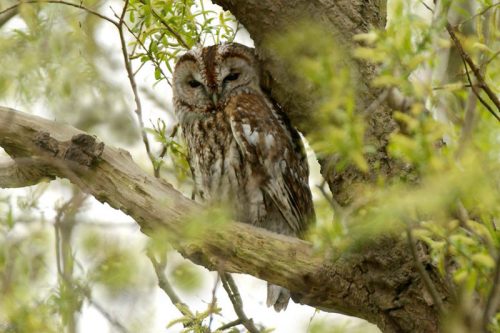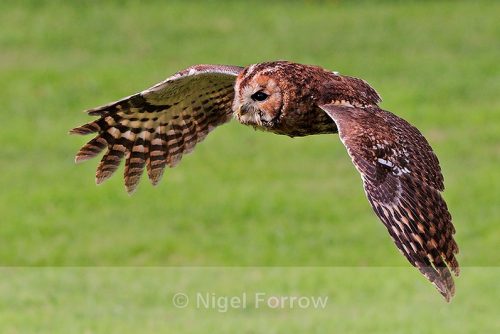The tawny owl (Strix aluco) is a medium-sized brown bird found commonly in Eurasia. The owl is believed to be highly territorial and migratory. It is a nocturnal species and is likely to prey on rodents. It makes nest in an abandoned tree cavity to go by potential predators. Tawny owls are highly vocal birds. Northern goshawk and eagle owl are the main predators of tawny owl.
Tawny Owl Facts
Anatomy
- The adult tawny owl reaches a length of about 37–46 cm (15–18 in) with the wingspan measuring up to 81–105 cm (32–41 in).
- The head to tail length is about 37 – 39 cm.
- Tawny owl has 148 – 210 mm long tail.
- They weigh up to 385 to 800 g (0.849 to 1.764 lb). Males average 420 grams while females average 520 grams in weight.
- There are no ear tufts on the large rounded head. Tawny owls have plain fascial disc that surrounds the dark brown eyes.
- Both males and females have white underparts. They have brown speckled plumage that goes reddish brown on the back while lighter on the front.
- Females seem to be 5% larger than males. They weigh 25% more than males.
- They take quite lethargic flight from the start but it is mostly silent.
- Tawny owls are smaller than the eagle owls, Ural owls, and great grey owls but it shares the same shape with these relatives.
- Unlike other diurnal birds of prey, tawny owl has a field overlap of 50 – 70% as its eyes are so placed. In low-light conditions the tawny owl has 100 times better eyesight as compared to humans.
- They have a remarkable ability to fly and see at night. The large size of the eye and 56,000 light-sensitive rod cells allow the bird to locate the prey quite precisely.
- They have keen hearing sense which is 10 times the hearing power of humans.
- Tawny owls often produce loud sounds such as kew-wick, or sometimes a song-like voice hoo…ho, ho, hoo-hoo-hoo-hoo, tut-tut, and tch-tch.
Read More: Owl’s Diet and Eating Habits

Distribution
- The tawny owl is distributed all throughout the Iberian Peninsula, India, and western Siberia. They are also found in the southern Scandinavia all the way to northwest Africa.
- The bird is absent from its former range of Ireland but it migrates towards the Canary Islands and Balearic.
- Europe is home to about 970,000–2,000,000 tawny owls.
- The geographic range includes western Iran, Nepal, Pakistan, southeast China, northern Indochina, Taiwan, Ukraine, Belgium, Netherlands, Albania, Finland, Norway, Italy, and Estonia.
Habitat
- The owl is known to make homes in diverse such as mixed forests, mature conifer plantations, and deciduous forests.
- It is likely to build habitats that are found near water.
- Tawny owls are adapted to living in urban areas including gardens, parks, clearings lookout trees, and cemeteries.
- It breeds from 550 meters (1,800 ft) in Scotland to 2,800 m (9,180 ft) in Turkey and fancy living in the cold areas.
Feeding Ecology & Diet
- Tawny owls are thought to feed at night but they will also prey during the day in order to feed young.
- They will consume woodland rodents and other small mammals including young rabbits, voles, rats, and hares. It eats beetles, birds, songbirds, house sparrows, ermine, and earthworms.
- Birds make up most of the tawny owls diet while mallards are rarely killed. Birds such as woodpeckers, domestic fowls, and doves are the prey of tawny owls.

Reproductive Biology
- They start breeding at the age of 1 year old.
- Tawny owls pair for life and they defend territories all year-round.
- Both male and female spends their entire day on a perch close to a tree branch. In the months of July to the end of October, they will roost separately.
- It will make use of tree holes that are previously abandoned by squirrels or European magpies.
- The nesting starts in February but in Scandinavia it begins in mid-March.
- Female lays eggs at intervals of 2 – 7 days.
- Female lays 2 – 3 glossy white eggs in a single clutch. The eggs reach a length of 48 x 39 mm (1.89 x 1.54 in) and weigh up to 39.0 g (1.4 oz).
- Outside the breeding season, they are solitary and hold a territory of 30 – 40 acres (0.1 – 0.2 sq. km).
- A female alone incubates the eggs and it lasts about one month.
- The young will fledge in 30 – 39 days after hatching. 10 days before fledging they are going to leave the nest.
- Regardless of its size, tawny is highly aggressive and is known to defend its territory without any fear. It will strike the predator with its sharp talons.
- Like other owl species, tawny owls also have a silent flight and they often go unnoticed.
- Eric Hosting, a famous photographer got too close to the tawny owl’s nest and before he could get back, the owl took out his left eye. Later he wrote a biography named, An Eye for a Bird.
- The parents guard the young chicks for 60 – 90 days. The young disperse from August to November.
- They must find a new territory, fails to do so they starve.
- The average lifespan of tawny owls is 5 years but a captive owl has lived up to 27 years max.
- Predators of tawny owl include northern goshawks, golden eagles, common buzzards, eagle owls, pine martins, Ural owls and red foxes.
Conservation
Least Concern


Leave a Reply